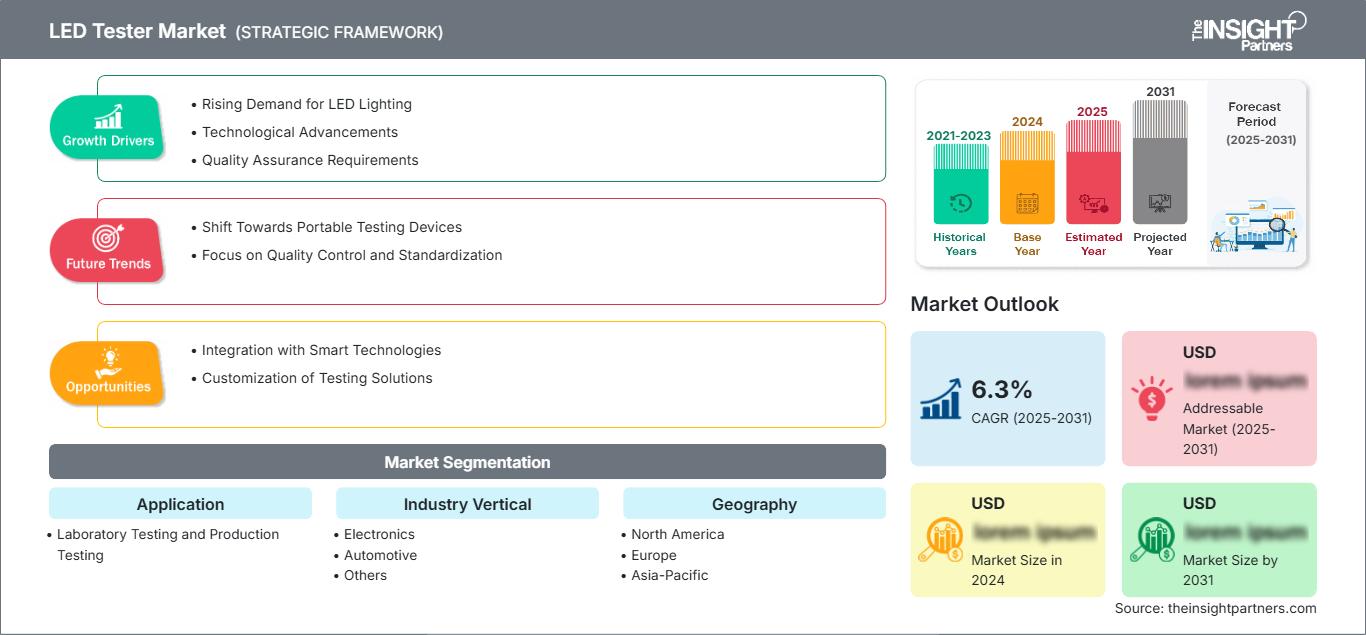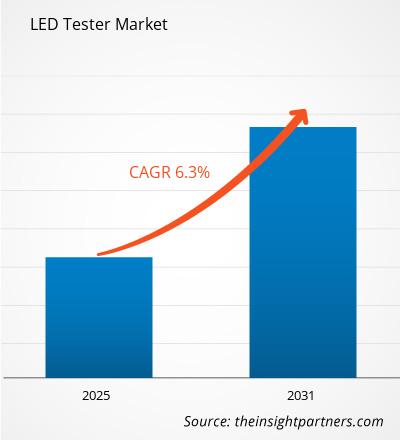Si prevede che il mercato dei tester LED registrerà un CAGR del 6,3% dal 2025 al 2031, con una dimensione del mercato in espansione da XX milioni di dollari nel 2024 a XX milioni di dollari entro il 2031.
Il rapporto è segmentato per applicazione (test di laboratorio e test di produzione) e settore verticale (elettronica, automotive e altri). L'analisi globale è ulteriormente suddivisa a livello regionale e per i principali paesi. Il rapporto offre il valore in USD per l'analisi e i segmenti sopra indicati.
Scopo del rapporto
Il rapporto "LED Tester Market" di The Insight Partners mira a descrivere il panorama attuale e la crescita futura, i principali fattori trainanti, le sfide e le opportunità. Ciò fornirà approfondimenti a vari stakeholder aziendali, come:
- Fornitori/produttori di tecnologia: per comprendere le dinamiche di mercato in evoluzione e conoscere le potenziali opportunità di crescita, consentendo loro di prendere decisioni strategiche informate.
- Investitori: per condurre un'analisi completa delle tendenze in merito al tasso di crescita del mercato, alle proiezioni finanziarie di mercato e alle opportunità esistenti lungo la catena del valore.
- Organismi di regolamentazione: per regolamentare le politiche e le attività di polizia nel mercato con l'obiettivo di ridurre al minimo gli abusi, preservare la fiducia degli investitori e sostenere l'integrità e la stabilità del mercato.
Applicazione della segmentazione del mercato dei tester LED
- Test di laboratorio e test di produzione
Settore verticale
- Elettronica
- Automotive
- Altri
Potrai personalizzare gratuitamente qualsiasi rapporto, comprese parti di questo rapporto, o analisi a livello di paese, pacchetto dati Excel, oltre a usufruire di grandi offerte e sconti per start-up e università
Mercato dei tester LED: Approfondimenti strategici

-
Ottieni le principali tendenze chiave del mercato di questo rapporto.Questo campione GRATUITO includerà l'analisi dei dati, che vanno dalle tendenze di mercato alle stime e alle previsioni.
Fattori di crescita del mercato dei tester LED
- Crescente domanda di illuminazione a LED: la crescente domanda di illuminazione a LED sta trainando significativamente la crescita del mercato, poiché consumatori e aziende pongono sempre più attenzione all'efficienza energetica. Le luci a LED impiegano più tempo e consumano meno energia, il che le rende la scelta preferita per l'illuminazione sostenibile in diverse applicazioni.
- Progressi tecnologici: il continuo miglioramento delle tecnologie delle apparecchiature di test LED sta aumentando la precisione e l'efficienza dei test, stimolando la crescita del mercato. Inoltre, i tester multifunzionali consentono ai produttori di garantire la qualità e le prestazioni dei prodotti, tenendo conto della crescente complessità dei sistemi di illuminazione a LED e delle aspettative dei consumatori in termini di affidabilità.
- Requisiti di garanzia della qualità: i requisiti di garanzia della qualità rappresentano la forza trainante dell'espansione del mercato, poiché le industrie cercano di conformarsi a standard più elevati per i prodotti a LED. Gli standard di qualità internazionali garantiscono la sicurezza e la fiducia dei consumatori, spingendo i produttori a investire in tester LED affidabili che garantiscano prestazioni e conformità alle normative vigenti.
Tendenze future del mercato dei tester LED
- Spostamento verso dispositivi di test portatili: il passaggio verso dispositivi di test portatili è una tendenza del mercato, poiché gli utenti cercano sempre più praticità e flessibilità. Questi strumenti compatti consentono test in loco, fornendo risultati rapidi e migliorando l'efficienza operativa, in particolare in settori come quello sanitario e dell'elettronica, dove un feedback immediato è fondamentale.
- Focus sul controllo qualità e sulla standardizzazione: con la crescente diffusione della tecnologia LED, le industrie stanno ponendo maggiore enfasi sul controllo qualità e sulla conformità agli standard internazionali, come IES e LM-79. I tester LED svolgono un ruolo fondamentale nel garantire che i prodotti LED soddisfino le specifiche richieste in termini di luminosità, coerenza del colore e prestazioni termiche. La necessità di rigorosi test di qualità e di standardizzazione dei prodotti sta guidando l'adozione di apparecchiature di test LED in tutte le unità produttive a livello globale.
Opportunità di mercato per i tester LED
- Integrazione con le tecnologie intelligenti: l'introduzione dei tester LED nelle tecnologie intelligenti sta quindi aprendo opportunità di mercato offrendo funzionalità di monitoraggio e analisi dei dati in tempo reale. Tale connettività consente di monitorare le prestazioni ed eseguire la manutenzione predittiva, diventando quindi più attraente per la maggior parte dei settori alla ricerca di sistemi di illuminazione efficienti e intelligenti.
- Personalizzazione delle soluzioni di test: la personalizzazione delle soluzioni di test sta creando significative opportunità di mercato, poiché i produttori possono personalizzare i tester LED per soddisfare specifiche esigenze di settore. Questa adattabilità migliora le prestazioni del prodotto e la soddisfazione degli utenti, consentendo alle aziende di differenziarsi e di soddisfare efficacemente diverse applicazioni.
Approfondimenti regionali sul mercato dei tester LED
Le tendenze regionali e i fattori che influenzano il mercato dei tester LED durante il periodo di previsione sono stati ampiamente spiegati dagli analisti di The Insight Partners. Questa sezione analizza anche i segmenti e la geografia del mercato dei tester LED in Nord America, Europa, Asia-Pacifico, Medio Oriente e Africa, America Meridionale e Centrale.
Ambito del rapporto di mercato sui tester LED
| Attributo del rapporto | Dettagli |
|---|---|
| Dimensioni del mercato in 2024 | US$ XX million |
| Dimensioni del mercato per 2031 | US$ XX Million |
| CAGR globale (2025 - 2031) | 6.3% |
| Dati storici | 2021-2023 |
| Periodo di previsione | 2025-2031 |
| Segmenti coperti |
By Applicazione
|
| Regioni e paesi coperti |
Nord America
|
| Leader di mercato e profili aziendali chiave |
|
Densità degli operatori del mercato dei tester LED: comprendere il suo impatto sulle dinamiche aziendali
Il mercato dei tester LED è in rapida crescita, trainato dalla crescente domanda degli utenti finali, dovuta a fattori quali l'evoluzione delle preferenze dei consumatori, i progressi tecnologici e una maggiore consapevolezza dei vantaggi del prodotto. Con l'aumento della domanda, le aziende stanno ampliando la propria offerta, innovando per soddisfare le esigenze dei consumatori e sfruttando le tendenze emergenti, alimentando ulteriormente la crescita del mercato.

- Ottieni il Mercato dei tester LED Panoramica dei principali attori chiave
Punti di forza
- Copertura completa: il rapporto analizza in modo esaustivo prodotti, servizi, tipologie e utenti finali del mercato dei tester LED, offrendo una panoramica olistica.
- Analisi degli esperti: il rapporto è redatto sulla base della conoscenza approfondita di esperti e analisti del settore.
- Informazioni aggiornate: il rapporto garantisce la pertinenza aziendale grazie alla copertura di informazioni e tendenze dei dati recenti.
- Opzioni di personalizzazione: questo rapporto può essere personalizzato per soddisfare le esigenze specifiche del cliente e adattarsi in modo appropriato alle strategie aziendali.
Il rapporto di ricerca sul mercato dei tester LED può quindi aiutare a guidare il percorso di decodifica e comprensione dello scenario del settore e delle prospettive di crescita. Sebbene possano esserci alcune preoccupazioni valide, i vantaggi complessivi di questo rapporto tendono a superare gli svantaggi.
- Analisi storica (2 anni), anno base, previsione (7 anni) con CAGR
- Analisi PEST e SWOT
- Valore/volume delle dimensioni del mercato - Globale, Regionale, Nazionale
- Industria e panorama competitivo
- Set di dati Excel
Report recenti
Rapporti correlati
Testimonianze
Motivo dell'acquisto
- Processo decisionale informato
- Comprensione delle dinamiche di mercato
- Analisi competitiva
- Analisi dei clienti
- Previsioni di mercato
- Mitigazione del rischio
- Pianificazione strategica
- Giustificazione degli investimenti
- Identificazione dei mercati emergenti
- Miglioramento delle strategie di marketing
- Aumento dell'efficienza operativa
- Allineamento alle tendenze normative






















 Ottieni un campione gratuito per - Mercato dei tester LED
Ottieni un campione gratuito per - Mercato dei tester LED